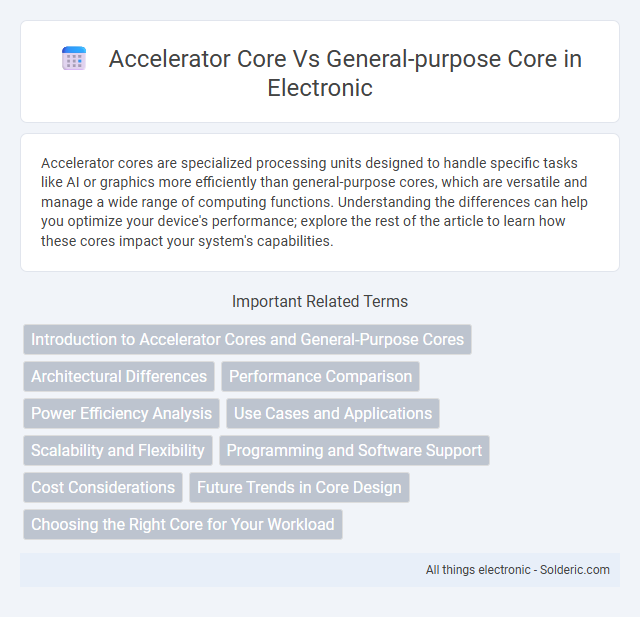Accelerator cores are specialized processing units designed to handle specific tasks like AI or graphics more efficiently than general-purpose cores, which are versatile and manage a wide range of computing functions. Understanding the differences can help you optimize your device's performance; explore the rest of the article to learn how these cores impact your system's capabilities.
Comparison Table
| Feature | Accelerator Core | General-Purpose Core |
|---|---|---|
| Function | Optimized for specific tasks or algorithms | Designed for a wide range of general computing tasks |
| Performance | High efficiency and speed for targeted operations | Moderate performance across various workloads |
| Power Consumption | Lower due to task specialization | Higher due to flexible processing capabilities |
| Instruction Set | Custom or limited instruction set focused on specific tasks | Rich, complex instruction set supporting diverse applications |
| Use Cases | Machine learning, video encoding, cryptography | Operating systems, application software, web browsing |
| Flexibility | Low; fixed-function or semi-programmable | High; fully programmable and versatile |
| Development Complexity | Higher for specific optimization | Lower with broad tool support |
Introduction to Accelerator Cores and General-Purpose Cores
Accelerator cores are specialized processing units designed to handle specific computational tasks such as graphics rendering, machine learning, or cryptographic operations, offering higher efficiency and performance for these workloads compared to general-purpose cores. General-purpose cores, found in CPUs, provide versatile processing capabilities capable of executing a wide range of instructions for diverse applications but often with less efficiency for specialized tasks. The distinction between accelerator cores and general-purpose cores lies in their architectural design and optimization, where accelerator cores emphasize high throughput and low latency for targeted functions, while general-purpose cores prioritize flexibility and seamless execution of general computing needs.
Architectural Differences
Accelerator cores are specialized processing units optimized for specific tasks such as AI inference or signal processing, featuring simplified instruction sets and dedicated hardware units to enhance performance and energy efficiency. General-purpose cores provide versatile processing capabilities with complex instruction sets, out-of-order execution, and extensive cache hierarchies to handle a wide variety of applications. The architectural focus of accelerator cores on parallelism and fixed-function pipelines contrasts with the flexible, programmable nature of general-purpose cores designed for broad computing workloads.
Performance Comparison
Accelerator cores deliver superior performance for specific tasks such as AI inference, graphics processing, and encryption by utilizing specialized hardware designed to optimize these workloads. General-purpose cores offer versatile performance across a broad range of applications but typically consume more power and deliver lower efficiency for specialized computations. Your system can achieve optimal speed and energy efficiency by combining accelerator cores with general-purpose cores, leveraging each for their strengths.
Power Efficiency Analysis
Accelerators cores deliver superior power efficiency compared to general-purpose cores by specializing in specific tasks, reducing redundant computations and unnecessary power draw. Their architecture is optimized to perform parallel processing and fixed-function operations, minimizing energy consumption per task. General-purpose cores, designed for versatility, consume more power due to the overhead of supporting diverse workloads and complex instruction sets.
Use Cases and Applications
Accelerator cores excel in specialized tasks such as AI inference, signal processing, and cryptographic computations, delivering higher efficiency and performance for dedicated workloads. General-purpose cores handle a wide range of applications including operating systems, user interfaces, and multi-threaded software, providing flexibility but often at lower power efficiency for specific tasks. Industries like automotive, aerospace, and data centers leverage accelerator cores for real-time processing and machine learning, while general-purpose cores remain essential for multitasking and supporting diverse software ecosystems.
Scalability and Flexibility
Accelerator cores are designed for high scalability, efficiently handling parallel tasks with specialized architectures that boost performance in specific applications like AI or graphics processing. General-purpose cores offer greater flexibility, running a wide range of software and adapting to diverse workloads but may sacrifice raw scalability compared to accelerators. Your choice depends on whether your priority is maximizing performance for specialized tasks or maintaining versatility across multiple computing demands.
Programming and Software Support
Accelerator cores often require specialized programming models, leveraging APIs like CUDA or OpenCL to optimize performance for specific tasks, while general-purpose cores support a broad range of languages and operating systems with mature software ecosystems. Your software development may involve integrating accelerator cores for compute-intensive workloads, demanding expertise in parallel programming and hardware-specific optimizations. General-purpose cores provide flexibility and ease of use for diverse applications, but may not match the efficiency gains offered by accelerators in targeted processing scenarios.
Cost Considerations
Accelerators cores reduce overall system cost by delivering high efficiency and performance for specific tasks, eliminating the need for powerful general-purpose cores. General-purpose cores increase manufacturing complexity and power consumption, which can drive up production and operational expenses. Incorporating accelerator cores allows optimized resource allocation, resulting in lower total cost of ownership and improved energy efficiency.
Future Trends in Core Design
Future trends in core design emphasize the integration of accelerator cores specialized for tasks like AI inference and machine learning alongside traditional general-purpose cores to boost overall system performance and energy efficiency. Heterogeneous architectures combining low-power cores with high-performance accelerator cores enable optimized workload distribution, supporting diverse applications from mobile devices to data centers. Advances in fabric technology and interconnect protocols are driving tighter coupling of accelerator and general-purpose cores, reducing latency and enhancing throughput in next-generation processors.
Choosing the Right Core for Your Workload
Accelerator cores are specialized processing units designed to handle specific tasks like AI inference or multimedia processing with high efficiency and low power consumption, making them ideal for workloads requiring speed and precision in dedicated functions. General-purpose cores offer versatile performance capable of running diverse applications and operating systems, providing flexibility but often at the cost of higher power usage and lower efficiency for specialized tasks. Evaluating your workload's requirements for speed, power efficiency, and task specificity will help you choose the right core to optimize performance and resource utilization.
Accelerator core vs general-purpose core Infographic

 solderic.com
solderic.com